University Healthcare Case Study: Crohn's Disease Patient Analysis
VerifiedAdded on 2022/09/06
|7
|1613
|35
Case Study
AI Summary
This case study presents an in-depth analysis of a patient suffering from Crohn's disease, an inflammatory bowel disease. The assignment details the patient's symptoms, including abdominal pain, nausea, weight loss, and fever, and explores the underlying causes and pathophysiology of the disease. It examines the role of genetic and environmental factors, as well as the impact on the gastrointestinal tract. The case study also delves into the patient's clinical observations, such as low blood pressure, elevated pulse and respiratory rates, and abnormal blood and urine reports. Furthermore, it discusses the treatments administered, including Hartmann's solution and methylprednisolone, explaining their mechanisms of action and therapeutic benefits in managing the condition. The assignment concludes by providing a comprehensive overview of Crohn's disease and its management.

Running head: CASE STUDY
Case Study
Name of the Student
Name of the University
Author Note
Case Study
Name of the Student
Name of the University
Author Note
Paraphrase This Document
Need a fresh take? Get an instant paraphrase of this document with our AI Paraphraser
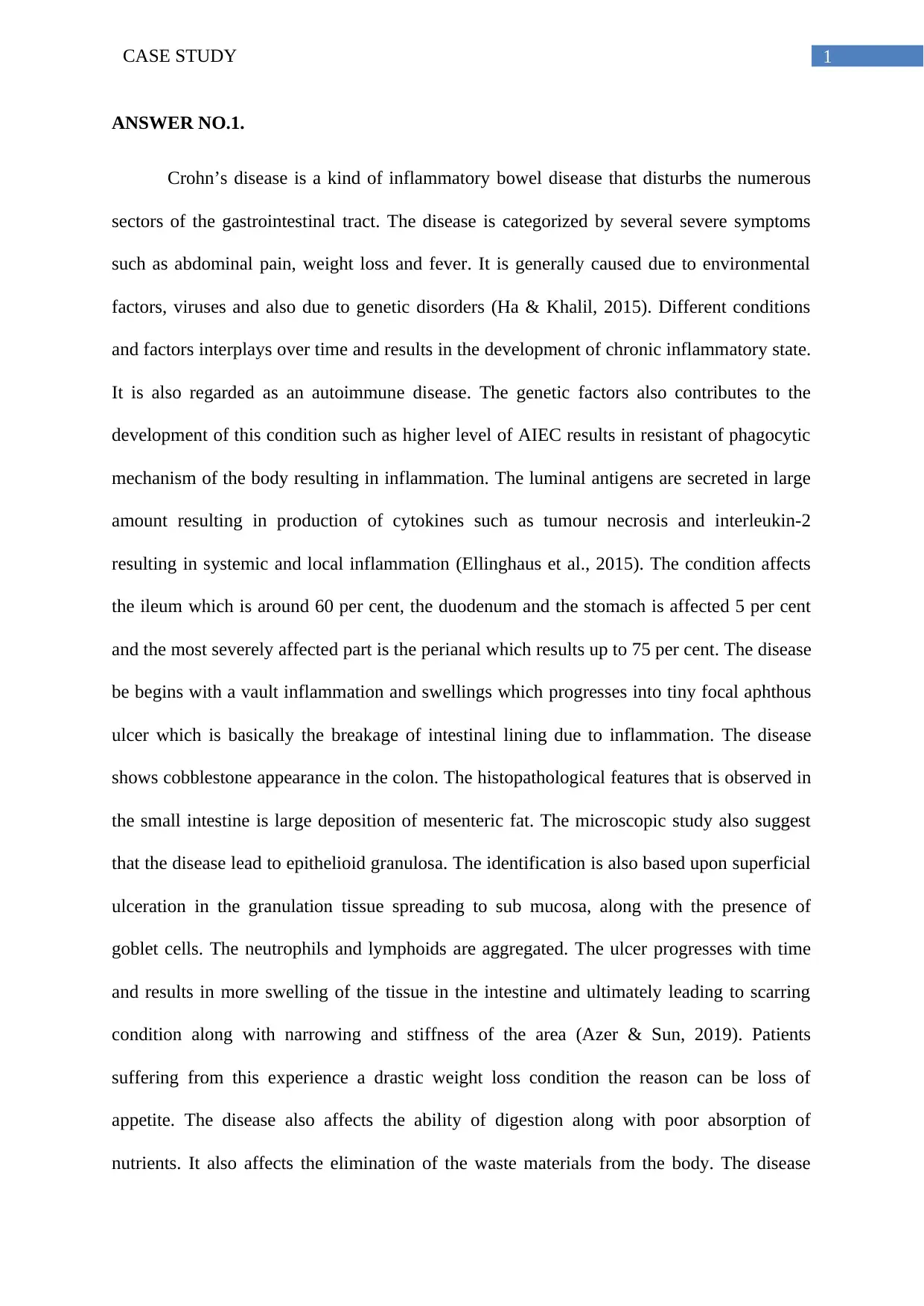
1CASE STUDY
ANSWER NO.1.
Crohn’s disease is a kind of inflammatory bowel disease that disturbs the numerous
sectors of the gastrointestinal tract. The disease is categorized by several severe symptoms
such as abdominal pain, weight loss and fever. It is generally caused due to environmental
factors, viruses and also due to genetic disorders (Ha & Khalil, 2015). Different conditions
and factors interplays over time and results in the development of chronic inflammatory state.
It is also regarded as an autoimmune disease. The genetic factors also contributes to the
development of this condition such as higher level of AIEC results in resistant of phagocytic
mechanism of the body resulting in inflammation. The luminal antigens are secreted in large
amount resulting in production of cytokines such as tumour necrosis and interleukin-2
resulting in systemic and local inflammation (Ellinghaus et al., 2015). The condition affects
the ileum which is around 60 per cent, the duodenum and the stomach is affected 5 per cent
and the most severely affected part is the perianal which results up to 75 per cent. The disease
be begins with a vault inflammation and swellings which progresses into tiny focal aphthous
ulcer which is basically the breakage of intestinal lining due to inflammation. The disease
shows cobblestone appearance in the colon. The histopathological features that is observed in
the small intestine is large deposition of mesenteric fat. The microscopic study also suggest
that the disease lead to epithelioid granulosa. The identification is also based upon superficial
ulceration in the granulation tissue spreading to sub mucosa, along with the presence of
goblet cells. The neutrophils and lymphoids are aggregated. The ulcer progresses with time
and results in more swelling of the tissue in the intestine and ultimately leading to scarring
condition along with narrowing and stiffness of the area (Azer & Sun, 2019). Patients
suffering from this experience a drastic weight loss condition the reason can be loss of
appetite. The disease also affects the ability of digestion along with poor absorption of
nutrients. It also affects the elimination of the waste materials from the body. The disease
ANSWER NO.1.
Crohn’s disease is a kind of inflammatory bowel disease that disturbs the numerous
sectors of the gastrointestinal tract. The disease is categorized by several severe symptoms
such as abdominal pain, weight loss and fever. It is generally caused due to environmental
factors, viruses and also due to genetic disorders (Ha & Khalil, 2015). Different conditions
and factors interplays over time and results in the development of chronic inflammatory state.
It is also regarded as an autoimmune disease. The genetic factors also contributes to the
development of this condition such as higher level of AIEC results in resistant of phagocytic
mechanism of the body resulting in inflammation. The luminal antigens are secreted in large
amount resulting in production of cytokines such as tumour necrosis and interleukin-2
resulting in systemic and local inflammation (Ellinghaus et al., 2015). The condition affects
the ileum which is around 60 per cent, the duodenum and the stomach is affected 5 per cent
and the most severely affected part is the perianal which results up to 75 per cent. The disease
be begins with a vault inflammation and swellings which progresses into tiny focal aphthous
ulcer which is basically the breakage of intestinal lining due to inflammation. The disease
shows cobblestone appearance in the colon. The histopathological features that is observed in
the small intestine is large deposition of mesenteric fat. The microscopic study also suggest
that the disease lead to epithelioid granulosa. The identification is also based upon superficial
ulceration in the granulation tissue spreading to sub mucosa, along with the presence of
goblet cells. The neutrophils and lymphoids are aggregated. The ulcer progresses with time
and results in more swelling of the tissue in the intestine and ultimately leading to scarring
condition along with narrowing and stiffness of the area (Azer & Sun, 2019). Patients
suffering from this experience a drastic weight loss condition the reason can be loss of
appetite. The disease also affects the ability of digestion along with poor absorption of
nutrients. It also affects the elimination of the waste materials from the body. The disease
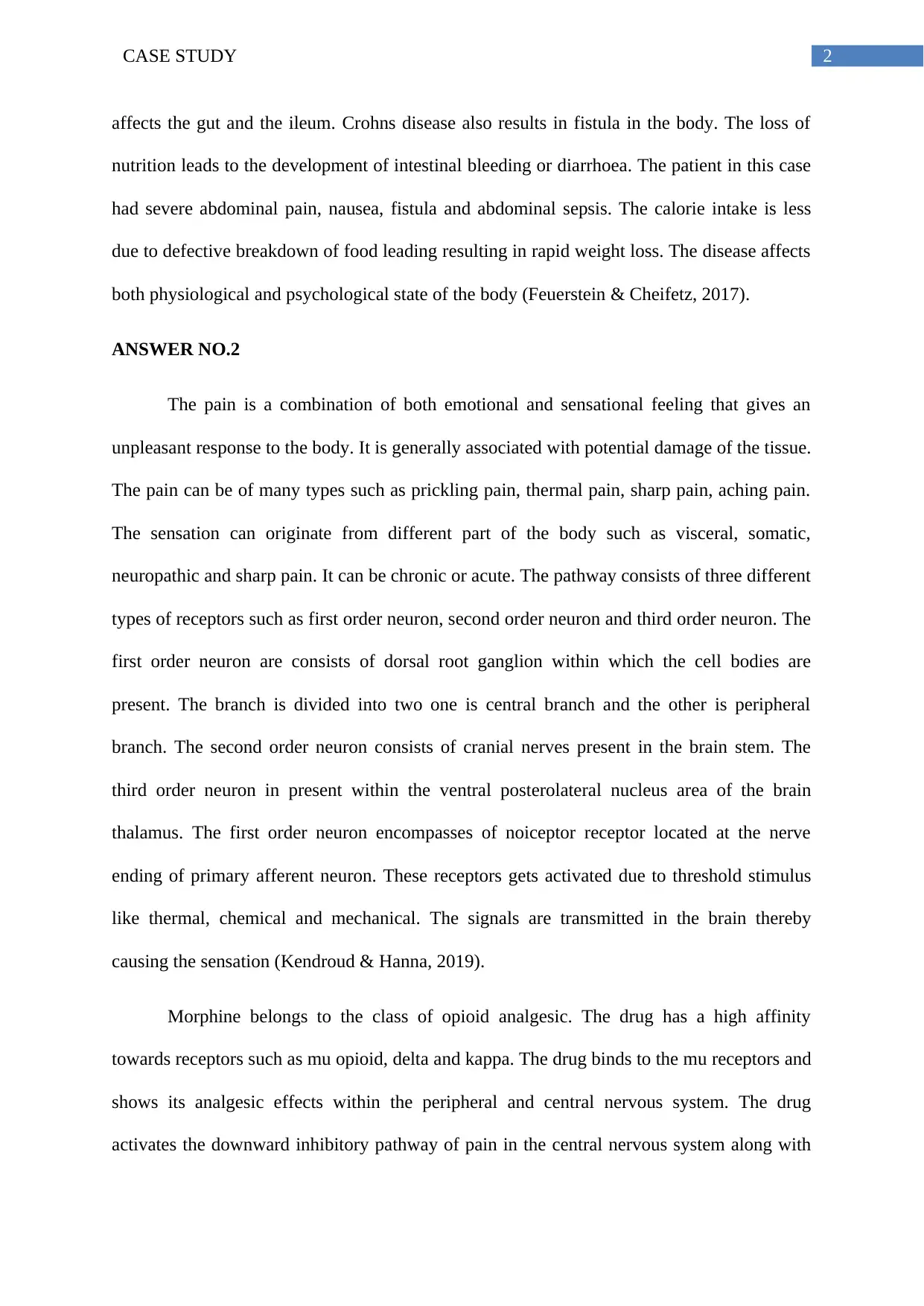
2CASE STUDY
affects the gut and the ileum. Crohns disease also results in fistula in the body. The loss of
nutrition leads to the development of intestinal bleeding or diarrhoea. The patient in this case
had severe abdominal pain, nausea, fistula and abdominal sepsis. The calorie intake is less
due to defective breakdown of food leading resulting in rapid weight loss. The disease affects
both physiological and psychological state of the body (Feuerstein & Cheifetz, 2017).
ANSWER NO.2
The pain is a combination of both emotional and sensational feeling that gives an
unpleasant response to the body. It is generally associated with potential damage of the tissue.
The pain can be of many types such as prickling pain, thermal pain, sharp pain, aching pain.
The sensation can originate from different part of the body such as visceral, somatic,
neuropathic and sharp pain. It can be chronic or acute. The pathway consists of three different
types of receptors such as first order neuron, second order neuron and third order neuron. The
first order neuron are consists of dorsal root ganglion within which the cell bodies are
present. The branch is divided into two one is central branch and the other is peripheral
branch. The second order neuron consists of cranial nerves present in the brain stem. The
third order neuron in present within the ventral posterolateral nucleus area of the brain
thalamus. The first order neuron encompasses of noiceptor receptor located at the nerve
ending of primary afferent neuron. These receptors gets activated due to threshold stimulus
like thermal, chemical and mechanical. The signals are transmitted in the brain thereby
causing the sensation (Kendroud & Hanna, 2019).
Morphine belongs to the class of opioid analgesic. The drug has a high affinity
towards receptors such as mu opioid, delta and kappa. The drug binds to the mu receptors and
shows its analgesic effects within the peripheral and central nervous system. The drug
activates the downward inhibitory pathway of pain in the central nervous system along with
affects the gut and the ileum. Crohns disease also results in fistula in the body. The loss of
nutrition leads to the development of intestinal bleeding or diarrhoea. The patient in this case
had severe abdominal pain, nausea, fistula and abdominal sepsis. The calorie intake is less
due to defective breakdown of food leading resulting in rapid weight loss. The disease affects
both physiological and psychological state of the body (Feuerstein & Cheifetz, 2017).
ANSWER NO.2
The pain is a combination of both emotional and sensational feeling that gives an
unpleasant response to the body. It is generally associated with potential damage of the tissue.
The pain can be of many types such as prickling pain, thermal pain, sharp pain, aching pain.
The sensation can originate from different part of the body such as visceral, somatic,
neuropathic and sharp pain. It can be chronic or acute. The pathway consists of three different
types of receptors such as first order neuron, second order neuron and third order neuron. The
first order neuron are consists of dorsal root ganglion within which the cell bodies are
present. The branch is divided into two one is central branch and the other is peripheral
branch. The second order neuron consists of cranial nerves present in the brain stem. The
third order neuron in present within the ventral posterolateral nucleus area of the brain
thalamus. The first order neuron encompasses of noiceptor receptor located at the nerve
ending of primary afferent neuron. These receptors gets activated due to threshold stimulus
like thermal, chemical and mechanical. The signals are transmitted in the brain thereby
causing the sensation (Kendroud & Hanna, 2019).
Morphine belongs to the class of opioid analgesic. The drug has a high affinity
towards receptors such as mu opioid, delta and kappa. The drug binds to the mu receptors and
shows its analgesic effects within the peripheral and central nervous system. The drug
activates the downward inhibitory pathway of pain in the central nervous system along with
⊘ This is a preview!⊘
Do you want full access?
Subscribe today to unlock all pages.

Trusted by 1+ million students worldwide
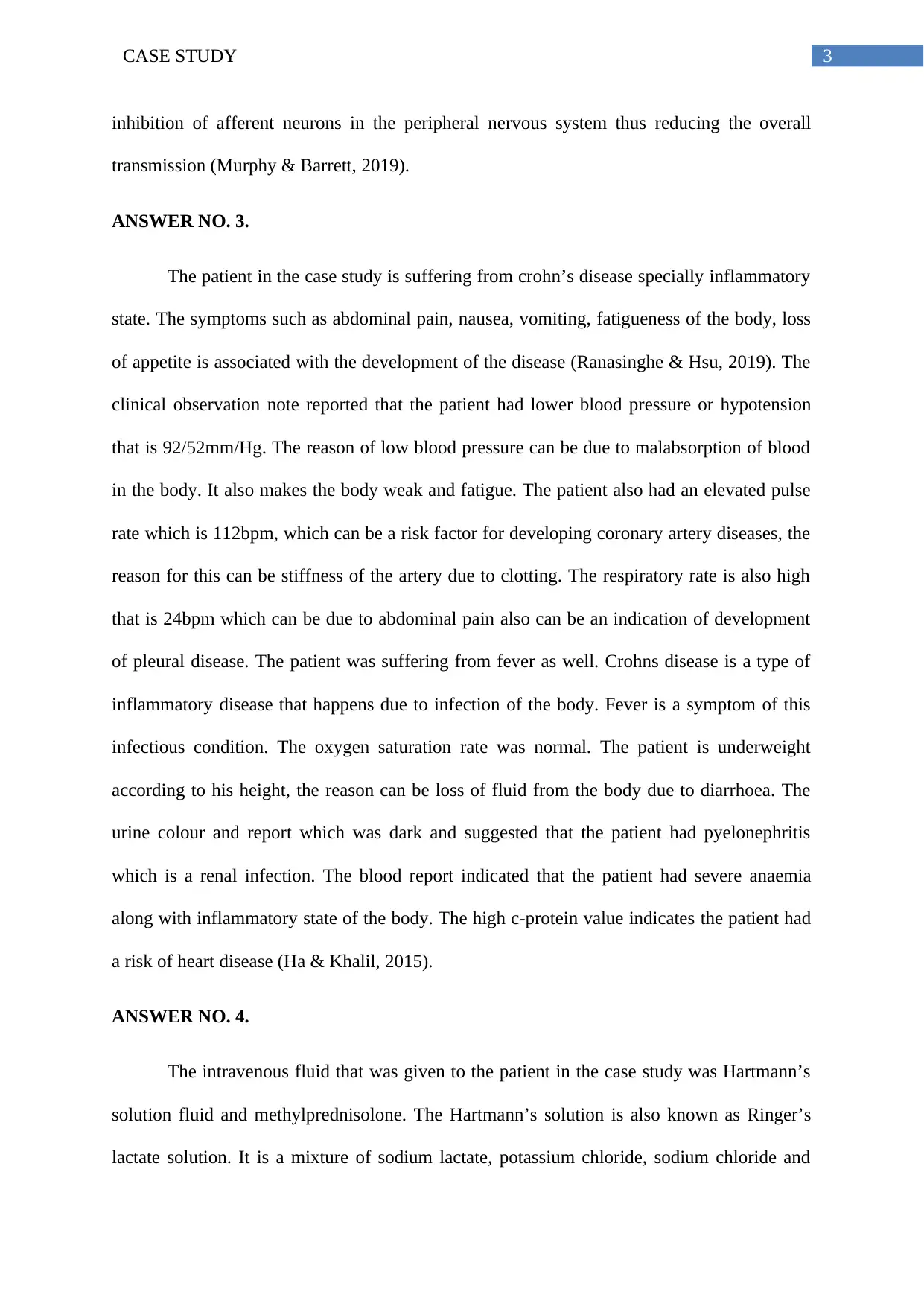
3CASE STUDY
inhibition of afferent neurons in the peripheral nervous system thus reducing the overall
transmission (Murphy & Barrett, 2019).
ANSWER NO. 3.
The patient in the case study is suffering from crohn’s disease specially inflammatory
state. The symptoms such as abdominal pain, nausea, vomiting, fatigueness of the body, loss
of appetite is associated with the development of the disease (Ranasinghe & Hsu, 2019). The
clinical observation note reported that the patient had lower blood pressure or hypotension
that is 92/52mm/Hg. The reason of low blood pressure can be due to malabsorption of blood
in the body. It also makes the body weak and fatigue. The patient also had an elevated pulse
rate which is 112bpm, which can be a risk factor for developing coronary artery diseases, the
reason for this can be stiffness of the artery due to clotting. The respiratory rate is also high
that is 24bpm which can be due to abdominal pain also can be an indication of development
of pleural disease. The patient was suffering from fever as well. Crohns disease is a type of
inflammatory disease that happens due to infection of the body. Fever is a symptom of this
infectious condition. The oxygen saturation rate was normal. The patient is underweight
according to his height, the reason can be loss of fluid from the body due to diarrhoea. The
urine colour and report which was dark and suggested that the patient had pyelonephritis
which is a renal infection. The blood report indicated that the patient had severe anaemia
along with inflammatory state of the body. The high c-protein value indicates the patient had
a risk of heart disease (Ha & Khalil, 2015).
ANSWER NO. 4.
The intravenous fluid that was given to the patient in the case study was Hartmann’s
solution fluid and methylprednisolone. The Hartmann’s solution is also known as Ringer’s
lactate solution. It is a mixture of sodium lactate, potassium chloride, sodium chloride and
inhibition of afferent neurons in the peripheral nervous system thus reducing the overall
transmission (Murphy & Barrett, 2019).
ANSWER NO. 3.
The patient in the case study is suffering from crohn’s disease specially inflammatory
state. The symptoms such as abdominal pain, nausea, vomiting, fatigueness of the body, loss
of appetite is associated with the development of the disease (Ranasinghe & Hsu, 2019). The
clinical observation note reported that the patient had lower blood pressure or hypotension
that is 92/52mm/Hg. The reason of low blood pressure can be due to malabsorption of blood
in the body. It also makes the body weak and fatigue. The patient also had an elevated pulse
rate which is 112bpm, which can be a risk factor for developing coronary artery diseases, the
reason for this can be stiffness of the artery due to clotting. The respiratory rate is also high
that is 24bpm which can be due to abdominal pain also can be an indication of development
of pleural disease. The patient was suffering from fever as well. Crohns disease is a type of
inflammatory disease that happens due to infection of the body. Fever is a symptom of this
infectious condition. The oxygen saturation rate was normal. The patient is underweight
according to his height, the reason can be loss of fluid from the body due to diarrhoea. The
urine colour and report which was dark and suggested that the patient had pyelonephritis
which is a renal infection. The blood report indicated that the patient had severe anaemia
along with inflammatory state of the body. The high c-protein value indicates the patient had
a risk of heart disease (Ha & Khalil, 2015).
ANSWER NO. 4.
The intravenous fluid that was given to the patient in the case study was Hartmann’s
solution fluid and methylprednisolone. The Hartmann’s solution is also known as Ringer’s
lactate solution. It is a mixture of sodium lactate, potassium chloride, sodium chloride and
Paraphrase This Document
Need a fresh take? Get an instant paraphrase of this document with our AI Paraphraser
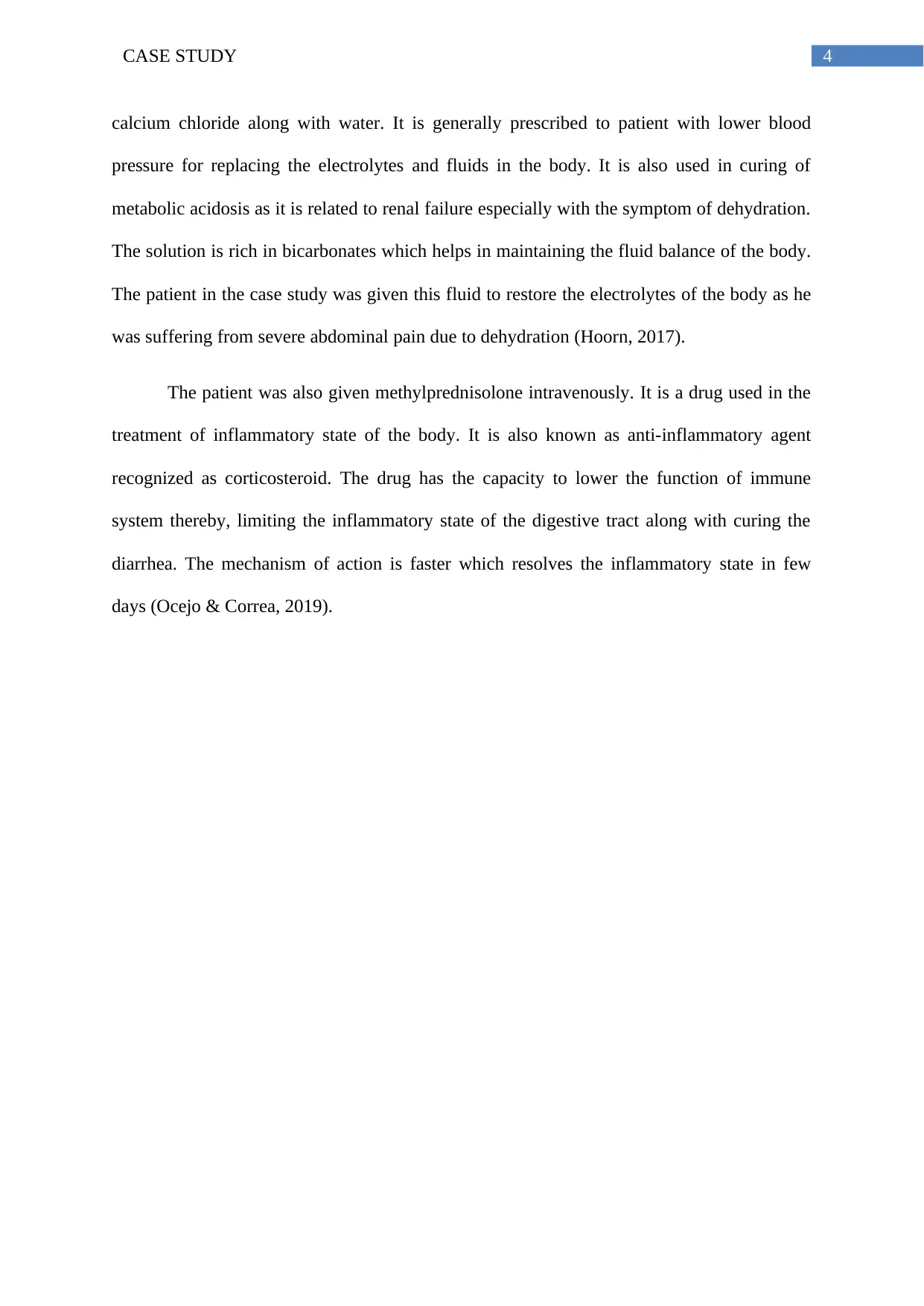
4CASE STUDY
calcium chloride along with water. It is generally prescribed to patient with lower blood
pressure for replacing the electrolytes and fluids in the body. It is also used in curing of
metabolic acidosis as it is related to renal failure especially with the symptom of dehydration.
The solution is rich in bicarbonates which helps in maintaining the fluid balance of the body.
The patient in the case study was given this fluid to restore the electrolytes of the body as he
was suffering from severe abdominal pain due to dehydration (Hoorn, 2017).
The patient was also given methylprednisolone intravenously. It is a drug used in the
treatment of inflammatory state of the body. It is also known as anti-inflammatory agent
recognized as corticosteroid. The drug has the capacity to lower the function of immune
system thereby, limiting the inflammatory state of the digestive tract along with curing the
diarrhea. The mechanism of action is faster which resolves the inflammatory state in few
days (Ocejo & Correa, 2019).
calcium chloride along with water. It is generally prescribed to patient with lower blood
pressure for replacing the electrolytes and fluids in the body. It is also used in curing of
metabolic acidosis as it is related to renal failure especially with the symptom of dehydration.
The solution is rich in bicarbonates which helps in maintaining the fluid balance of the body.
The patient in the case study was given this fluid to restore the electrolytes of the body as he
was suffering from severe abdominal pain due to dehydration (Hoorn, 2017).
The patient was also given methylprednisolone intravenously. It is a drug used in the
treatment of inflammatory state of the body. It is also known as anti-inflammatory agent
recognized as corticosteroid. The drug has the capacity to lower the function of immune
system thereby, limiting the inflammatory state of the digestive tract along with curing the
diarrhea. The mechanism of action is faster which resolves the inflammatory state in few
days (Ocejo & Correa, 2019).
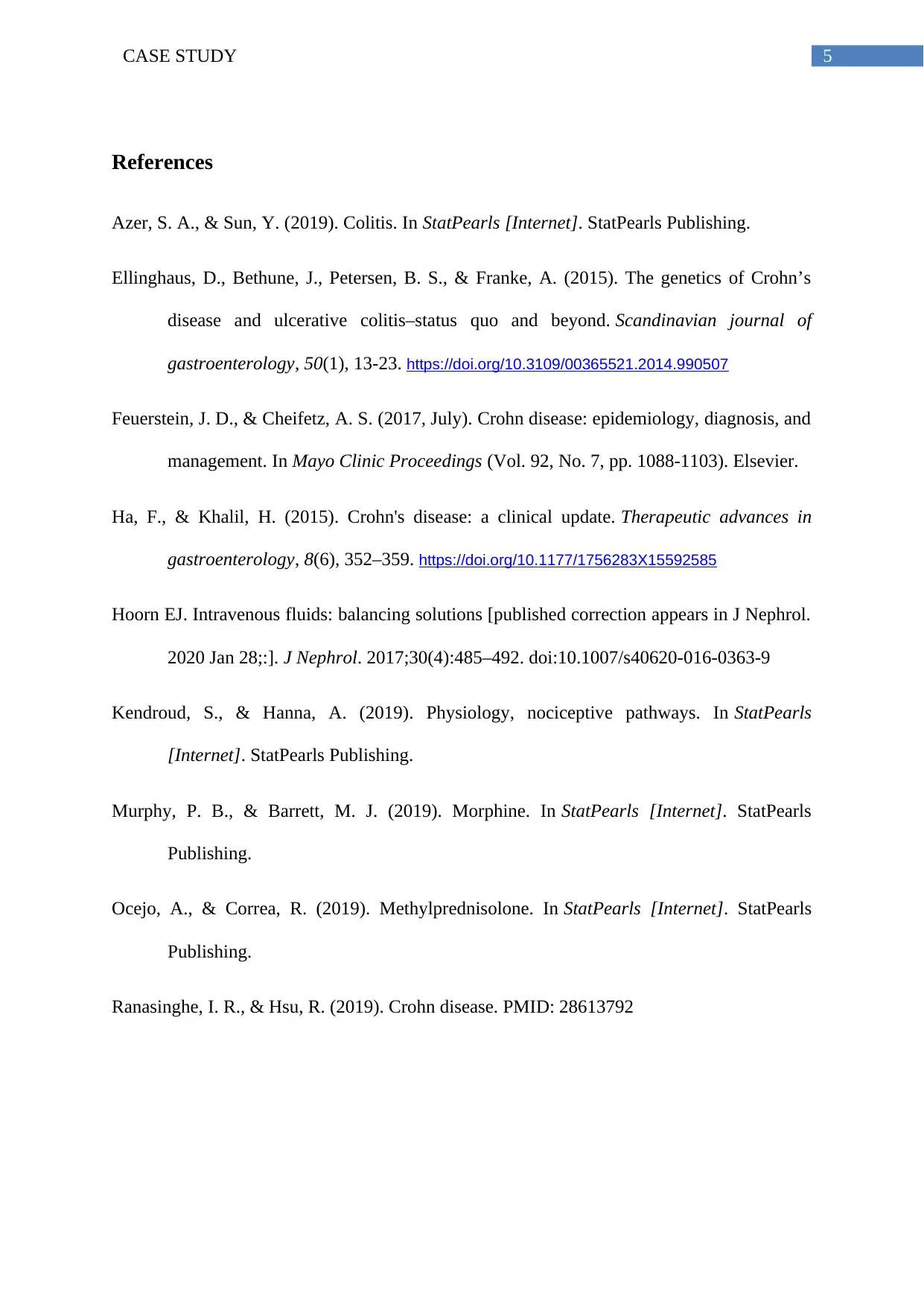
5CASE STUDY
References
Azer, S. A., & Sun, Y. (2019). Colitis. In StatPearls [Internet]. StatPearls Publishing.
Ellinghaus, D., Bethune, J., Petersen, B. S., & Franke, A. (2015). The genetics of Crohn’s
disease and ulcerative colitis–status quo and beyond. Scandinavian journal of
gastroenterology, 50(1), 13-23. https://doi.org/10.3109/00365521.2014.990507
Feuerstein, J. D., & Cheifetz, A. S. (2017, July). Crohn disease: epidemiology, diagnosis, and
management. In Mayo Clinic Proceedings (Vol. 92, No. 7, pp. 1088-1103). Elsevier.
Ha, F., & Khalil, H. (2015). Crohn's disease: a clinical update. Therapeutic advances in
gastroenterology, 8(6), 352–359. https://doi.org/10.1177/1756283X15592585
Hoorn EJ. Intravenous fluids: balancing solutions [published correction appears in J Nephrol.
2020 Jan 28;:]. J Nephrol. 2017;30(4):485–492. doi:10.1007/s40620-016-0363-9
Kendroud, S., & Hanna, A. (2019). Physiology, nociceptive pathways. In StatPearls
[Internet]. StatPearls Publishing.
Murphy, P. B., & Barrett, M. J. (2019). Morphine. In StatPearls [Internet]. StatPearls
Publishing.
Ocejo, A., & Correa, R. (2019). Methylprednisolone. In StatPearls [Internet]. StatPearls
Publishing.
Ranasinghe, I. R., & Hsu, R. (2019). Crohn disease. PMID: 28613792
References
Azer, S. A., & Sun, Y. (2019). Colitis. In StatPearls [Internet]. StatPearls Publishing.
Ellinghaus, D., Bethune, J., Petersen, B. S., & Franke, A. (2015). The genetics of Crohn’s
disease and ulcerative colitis–status quo and beyond. Scandinavian journal of
gastroenterology, 50(1), 13-23. https://doi.org/10.3109/00365521.2014.990507
Feuerstein, J. D., & Cheifetz, A. S. (2017, July). Crohn disease: epidemiology, diagnosis, and
management. In Mayo Clinic Proceedings (Vol. 92, No. 7, pp. 1088-1103). Elsevier.
Ha, F., & Khalil, H. (2015). Crohn's disease: a clinical update. Therapeutic advances in
gastroenterology, 8(6), 352–359. https://doi.org/10.1177/1756283X15592585
Hoorn EJ. Intravenous fluids: balancing solutions [published correction appears in J Nephrol.
2020 Jan 28;:]. J Nephrol. 2017;30(4):485–492. doi:10.1007/s40620-016-0363-9
Kendroud, S., & Hanna, A. (2019). Physiology, nociceptive pathways. In StatPearls
[Internet]. StatPearls Publishing.
Murphy, P. B., & Barrett, M. J. (2019). Morphine. In StatPearls [Internet]. StatPearls
Publishing.
Ocejo, A., & Correa, R. (2019). Methylprednisolone. In StatPearls [Internet]. StatPearls
Publishing.
Ranasinghe, I. R., & Hsu, R. (2019). Crohn disease. PMID: 28613792
⊘ This is a preview!⊘
Do you want full access?
Subscribe today to unlock all pages.

Trusted by 1+ million students worldwide

6CASE STUDY
1 out of 7
Related Documents
Your All-in-One AI-Powered Toolkit for Academic Success.
+13062052269
info@desklib.com
Available 24*7 on WhatsApp / Email
![[object Object]](/_next/static/media/star-bottom.7253800d.svg)
Unlock your academic potential
Copyright © 2020–2025 A2Z Services. All Rights Reserved. Developed and managed by ZUCOL.





